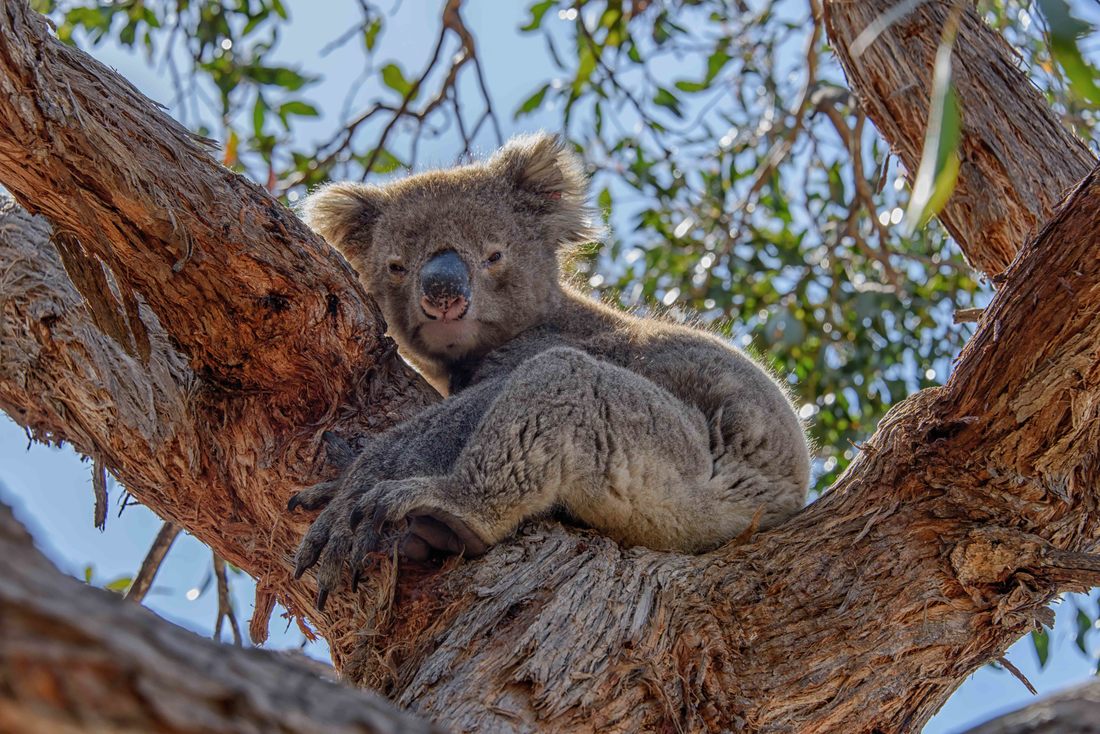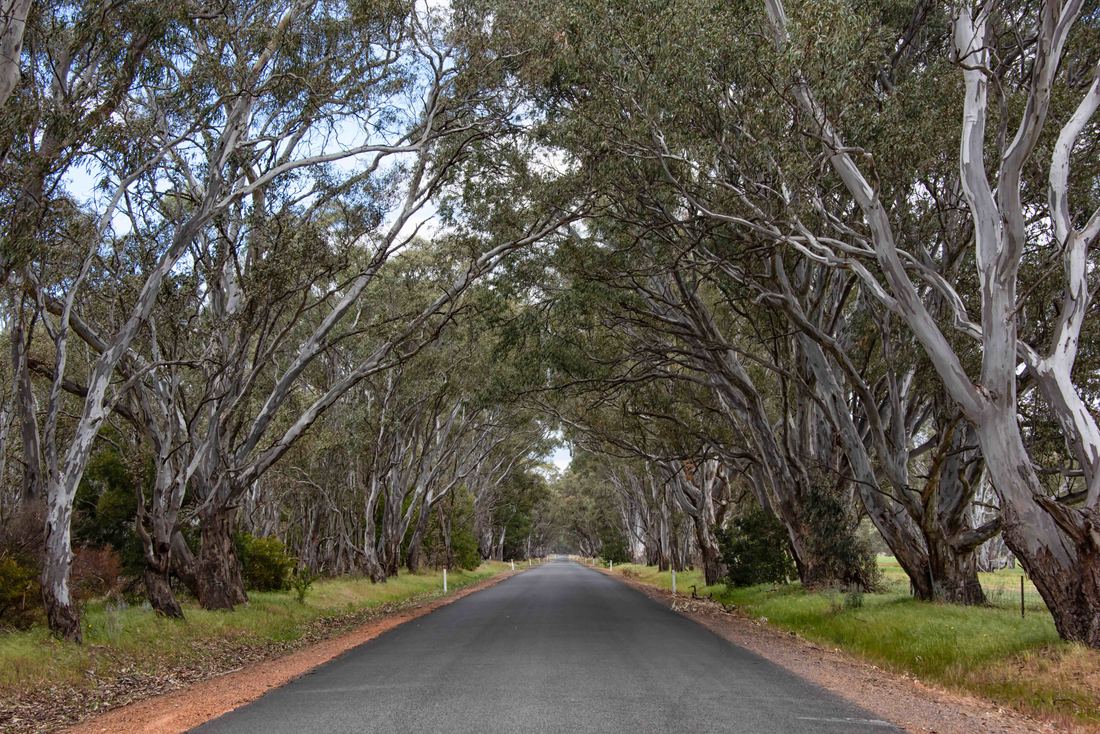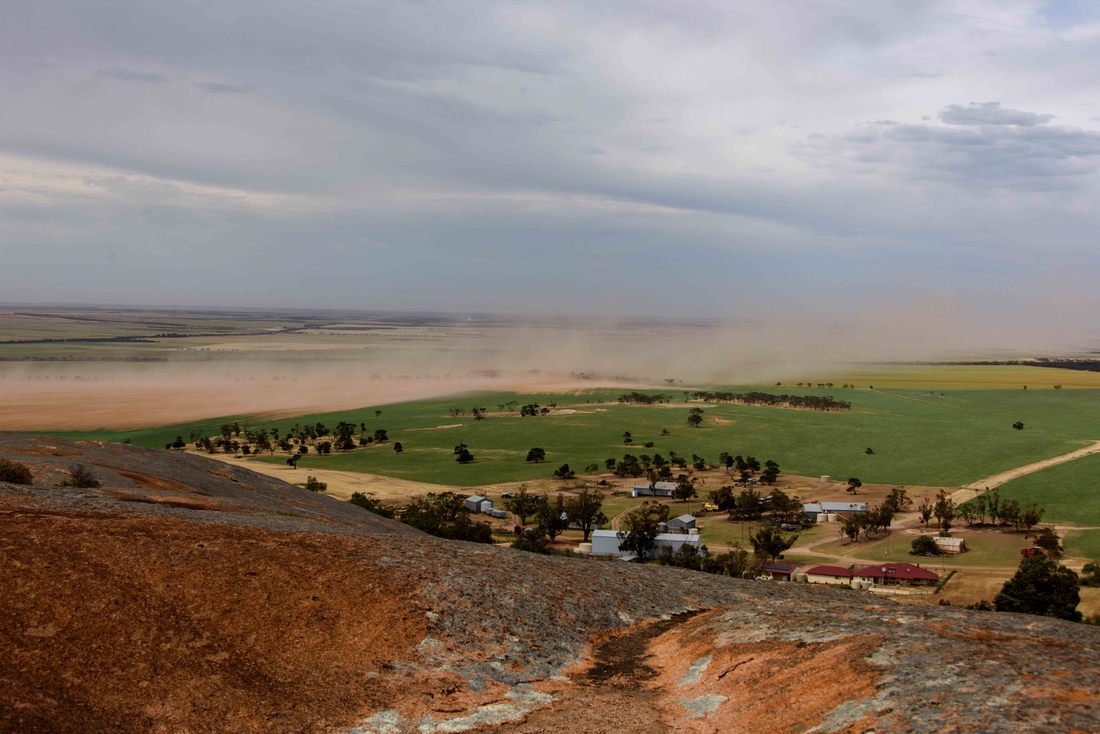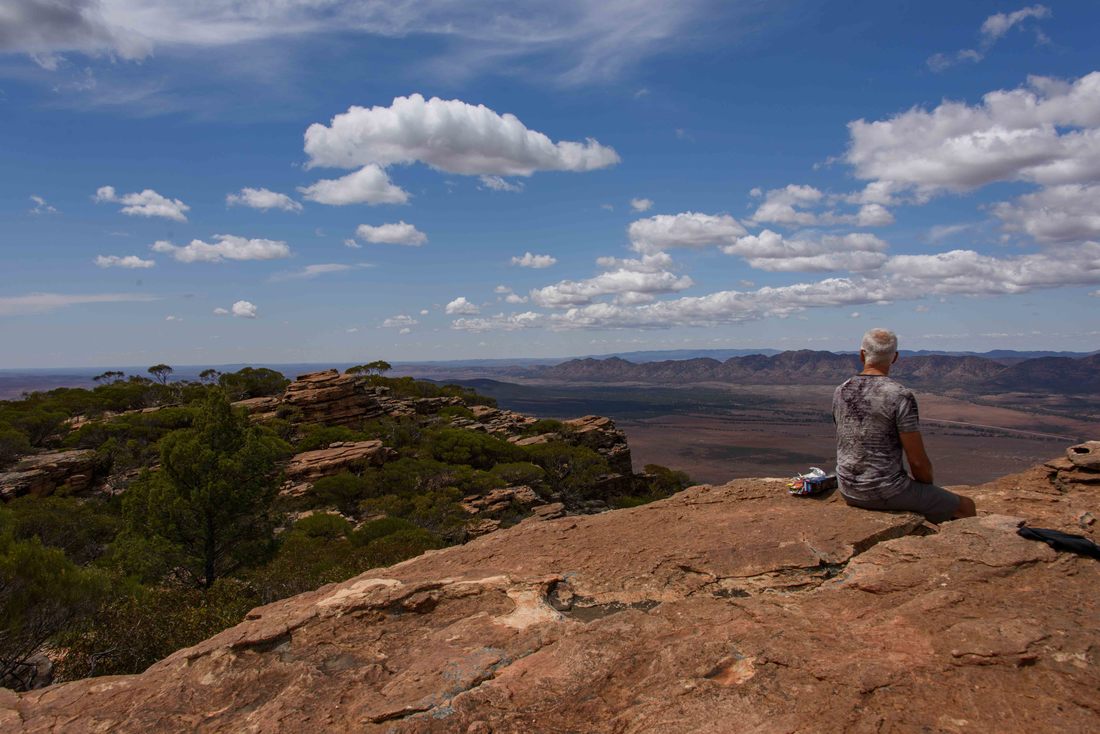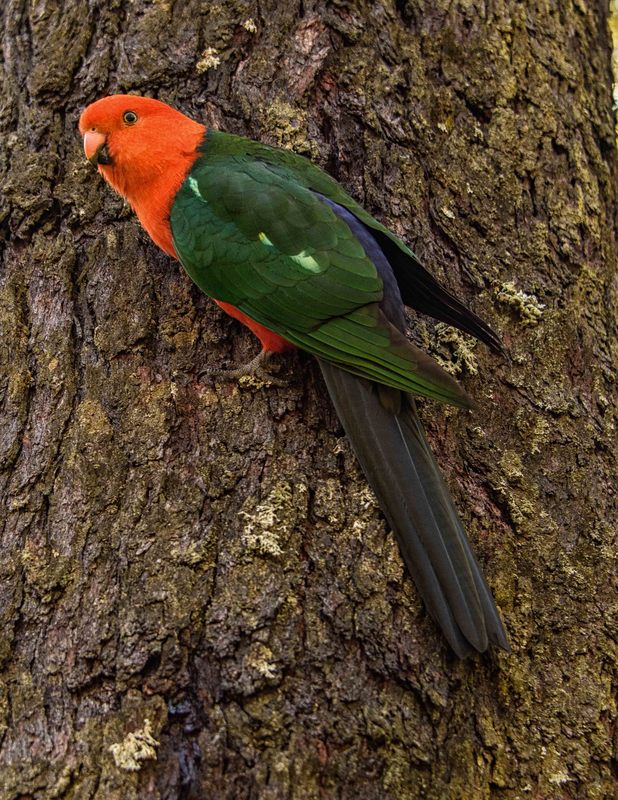After a few flights and 8,000 km added to the rental cars odometers, its finally time to return home. (Nov 14)
Kangaroo Island - one last hurrah for wildlife spotting. It’s so abundant that people are asked to not drive between dusk and dawn when the animals are most likely to end up road side. Above: Kangaroo Island Echidna rooting about for ants. Each time I clicked the camera he froze for a second...good thing I had that ninja training:) (Kangaroo Island, Nov 7-12)

Sven agreed to play stand-in for the Fairy Penguins nesting in our beach cabin rental's front yard. No flash photography was allowed as the diminutive birds (~13” tall) are particularly light sensitive. Each night they showed up at about 9pm and returned to the ocean at 4am, with the darkness providing some degree of safety. To catch a glimpse of them we had to sit perfectly still in the dark for ages as they explored our front porch and waddled about calling to each other.

Ligurian honey bees were first imported from Italy in the late 1800s. Their isolation on Kangaroo Island and vigorous safeguarding from other species has ensured that its population is the last pure strain left in the world. The sugar gum (eucalyptus) flavour was delicious, so different than at home.

To entice travelers to stop for a meal and maybe some shopping when they pull over for a photo, this community re-purposed its underutilized 30m high grain silos. These hometown primary schoolchildren (now minor celebrities) are meant to represent hope for the future and it seems to be working - the silos were only painted a year ago and already new businesses have opened. (Coonalpyn, Nov 6)

When soldiers returned from WW I they needed jobs and the rugged coastline of the state of Victoria needed a road. Thirteen years later the 243km Great Ocean Road was completed. With its dramatic coastline, surf beaches, koala rich national park and historic towns, it is considered one long war memorial and one of the country’s best road trips. Below: Torquay to Port Fairy, Oct 27-Nov 4.

Full of Manna Gum eucalyptus trees, the Great Otway National Park smells like the slightly peppery, celery scent of the gum leaves. Koalas can be seen and heard everywhere. They make an intimidating, low, growling sound that belies their cuddly looks. Although both sexes can make the sound, usually it’s the males looking to attract a mate. (Great Otway National Park, Oct 30-Nov 2)
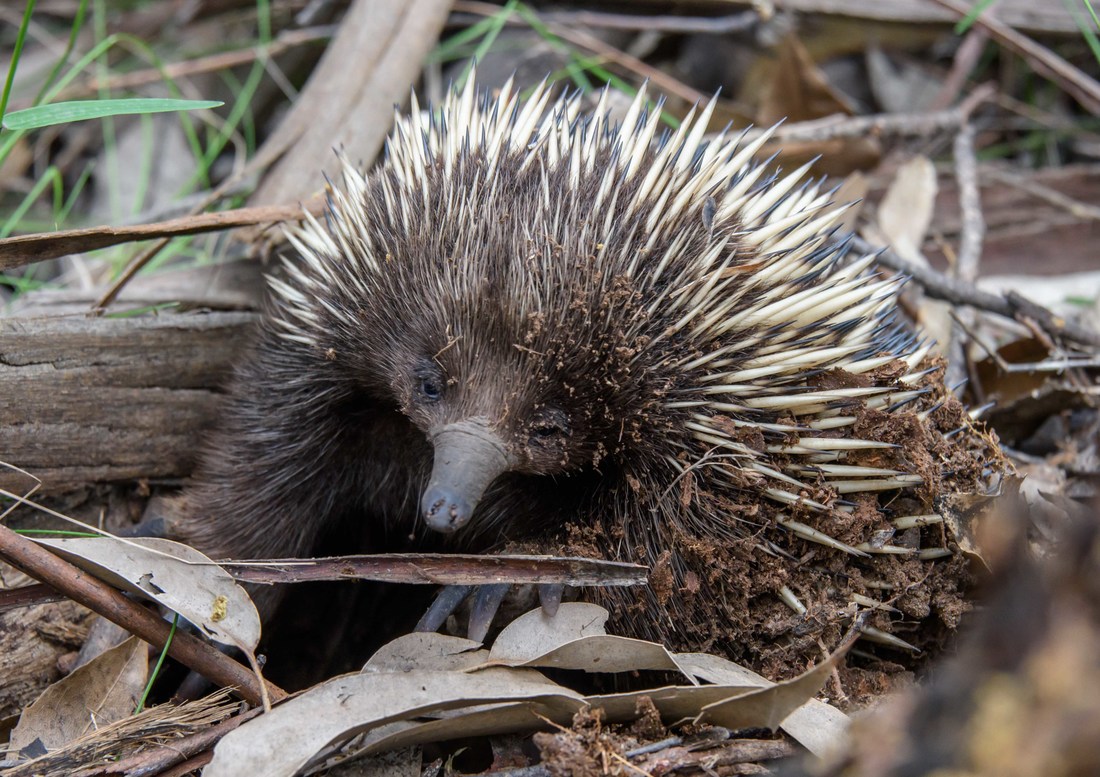
Patience and crouching perfectly still earned a couple of close-ups...Short-beaked Echidnas use their strong claws to dig up ants and termites. Along with the platypus, echidnas are the only egg laying mammals in existence. Unfortunately for the females, the thorny, clawed young (puggles) are reared in the pouch... until the day the baby’s spikes just get too painful for Mom and then it’s tough love and eviction. (Cape Otway {Great Otway National Park}, Nov 1-2)

As the town that hosts the world's longest continuously running surfing competition and where iconic surfing brands Rip Curl and Quiksilver started, its a fitting location for the National Surfing Museum. The above board was one of a line of several funny “letters home” themed surfboards - they all have Maurice the surfer’s note on the front with a with reply from Mom & Dad on the reverse...the recurrent theme was Maurice the surfer dude pleading for money. (Torquay, Oct 27)
Usually a group (a mob) have a home range of about 5km and the front lawn in front of our cabin fell within this mob’s territory. This was the first time we saw the joey out of Mom’s pouch and he was already running her ragged. (Halls Gap, Oct 26)

These White kangaroos are a genetic strain of the Eastern and Western Greys. There are also (rare) albinos, but unless you can get close enough to see the red eyes of the latter, you can’t really tell which is which. Interestingly, if there’s a threat of danger, non-white roos in the mob will surround and protect the whites, understanding that the latter are easier attack targets. (Bordertown, Oct 22)

Obvious signs of irrigation are unusual, with farmers opting instead to ‘dry farm’, leaving nature to decide the crop’s fate. Although less rain means less yield, the grain can end up being dense and protein rich, fetching a higher price. A farmer told us that this year he’s had to deal with both pitiful rainfall and large numbers of destructive “vermin” - he and his farmshare partners recently shot 300 emus and 400 kangaroos (those numbers are shockingly high)!

Cookie cutter windmills dot the countryside everywhere we’ve been - today’s 2 main suppliers began manufacturing these water pump icons in the late 1800s. Unlike much of the world, Australia’s rainfall usually ends up in groundwater basins rather than rivers. The Great Artesian Basin is the world’s largest, covering 22% of Australia. (Southern Mallee, Oct 22)

More fascination with trees...They may be one of the most common eucalyptus in Australia, but the River Red gums make a statement, whether dotting fields or bordering vineyards and roads. Although pretty to look at, they have the habit of unexpectedly dropping large boughs, earning them the nickname ‘widow maker’. The fallen boughs provide fertilizer for the remaining tree and food and shelter for insects and birds. (Clare Valley, Oct 21)

Mid-1800s churches and hotels continue to anchor the villages surrounding the town of Clare. When first built, they supported the men driving the horse-drawn carts (bullock drays), laden with copper, on their multi-day trips from the mines in the north to the shipyards in Adelaide. (Mintaro, Oct 21)

This abandoned cabin ended up on the cover of Midnight Oil’s ‘Diesel and Dust’ album from the 80s. Since then it has been a magnet for photographers. In a way it represents a common roadside scene especially prevalent in the outback - abandoned cabins left by earlier settlers who just couldn’t make a go of it in that inhospitable land.

Dolphins playing in the harbour - a mother and her 3 month old calf were hanging around a boat trying to get some free food but thankfully the captain followed the local requests not to feed them. If the cow is hand fed she isn’t spending time showing her calf how to hunt and survive on its own. (Whyalla, Oct 18)

A perfectly sublime day that will be remembered as a life highlight. The Mikkira (sheep) Station has a thicket of Old Manna gum trees which are favored by koalas. A small fee allowed visitors to wander the large property trying to spot any of the ~120 koalas who live there. For hours we had the place to ourselves, spending time seeking and then just quietly watching the subtle movements of these adorable creatures. Six hours and 51 koalas (including 7 joeys) later, we reluctantly left the farm.(Port Lincoln area, Oct 17)

Moments later Mom overreached, her supporting branch cracked and fell to the ground, the joey tumbled and we held our breath. Mom barely stopped eating while the joey righted itself. Perhaps due to poor nutrition, koalas have a small brain but with a disproportionately large amount of surrounding fluid. It’s thought that the latter may act as a shock absorber should the koala fall from the tree.

Mt Wudinna was the consolation for not climbing Uluru (Ayers Rock). Although it’s the country's second largest natural rock formation, at 261m high it’s a distant second to Uluru (863m). The day warned of high winds which only worsened the further we climbed. Staying upright in the ???!!!mph wind at the top of the rock was a challenge. Rick likened it to a carnival ride whereas I actually felt nervous and held him tightly to steady myself from blowing over. (Wudinna, Oct 14)

I’m fascinated by this look, in part because it reminds me of the 60s when my sister and I lived briefly up north in Cairns. In the early 1900s settlers built their homes with these uniquely Australian bullnose verandahs, shading them from the heat of the day. After WW I, more European architecture was adopted which fully exposed homes to the sunlight. But after baking in hot houses and paying for expensive air conditioning for decades, there has been a resurgence of these practical and picturesque patios. One builder’s website claimed that environmentalists recommend every home should have solar panels, a water tank and a bullnose verandah. (Quorn, Oct 13)
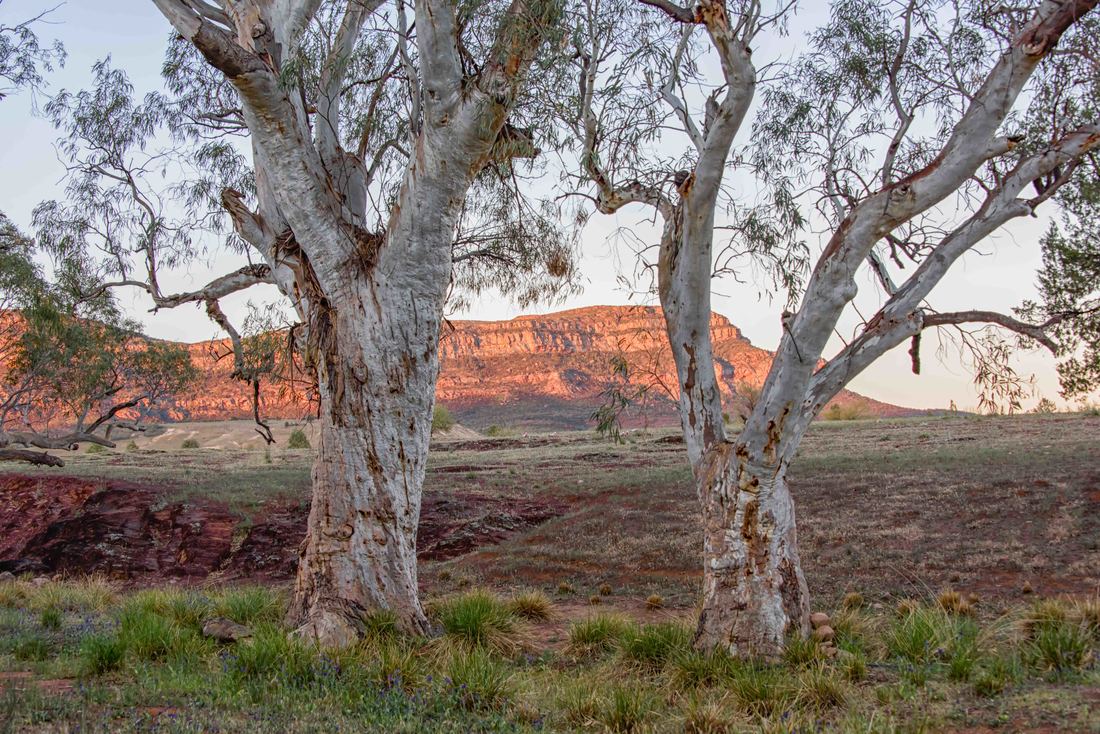
After finding fossils here so old that geologists had to define a new geologic era, it’s believed that the Flinders Ranges are among the oldest environments in the world at 500-800 million years old. This view was from our rented cabin. Cattle and sheep farms, called stations, are moving to the 'pastoralism to tourism' business where they rent out accommodation on their working stations. (Rawnsley Bluff in Flinders Ranges, Oct 10-12)

Sharing the road with few other travellers we drove for hours through the storied outback, passing deserted petrol stations, skittish emus and kangaroos every few kilometres and a couple of small towns sprinkled with late 19th/early 20th century buildings. Anyone whose seen an Australian outback miniseries will recognize the signature latticework and slim wooden column verandah of this early 1900s hotel. The Pride flag is being flown in a nod to the hotel's use in filming Prescilla, Queen of the Desert and the ongoing drag shows here. (Broken Hill to Hawker, Oct 10)

The welcome sign ‘Broken Hill, the Accessible Outback’ greets the traveler who has driven through 300km of parched land along blacktop bordered by a disturbing number of dead kangaroos-another driver stopped counting at 300. There's currently an overpopulation of the marsupials. About 8 years ago, decent rainfall contributed to an almost doubling of the kangaroo population (27 to 44
million). To deal with the problem, people started being encouraged to eat the safe and lean meat and culling quotas were put in place. But the professional hunters aren't meeting the quotas leaving the animals competing for less food and water in now drought-stricken N.W. New South Wales. (Mildura to Broken Hill, Oct 7)
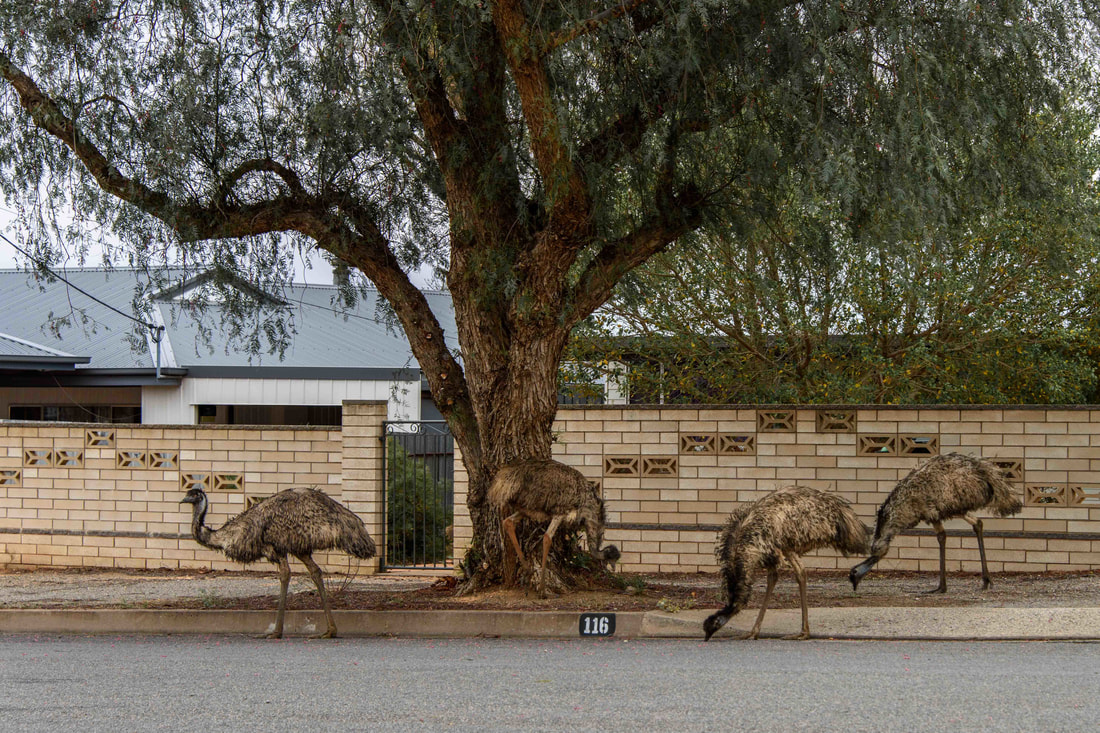
Emus wandering the town in search of food, but most importantly water. A resident of 40 yrs said she’d never seen them come into town like this-many townspeople are responding by leaving out buckets of drinking water. Ironically, it rained 2 of the 3 nights we were there - must be that wet Vancouver charm we brought with us :) (Broken Hill, Oct 7-9)

Royal Flying Doctors Service - the largest aeromedical service in the world. This RFDS base with its few
doctors and only one dentist covers 640,000 sq km, providing the only medical care many a cattle/sheep station or bush settlement will receive. An 80s TV show chronicling the organization's many heroics has inspired still active fund raising from as far away as Germany.

The RFDS has provided many people (>3,000) living in remote areas with a comprehensive medical chest. When there’s an emergency, the patient calls the base for instructions on how to use the various drugs, needles, splints, etc. As a fitting souvenir we bought their much scaled down first aid kit. Two days later, and kilometres from a town, it was pulled out to clean and bandage my index finger after a decent cut from a dirty bathroom door...next up came the tetanus shot.

Driving through the Riverland wine region past familiar names like Wolf Blass (processing 1,000,000 bottles/day) and Banrock Station, sat this every-mans winery. The sales lady explained that port, devoid of its current cache, was the Aussie’s original drink of choice before its non-fortified version gained popularity. A favorite way to consume - sucked through a biscuit before eating the liquor drenched bikkie. No wonder it doesn’t have to be aged for 25 years :). (Renmark, Oct 5)
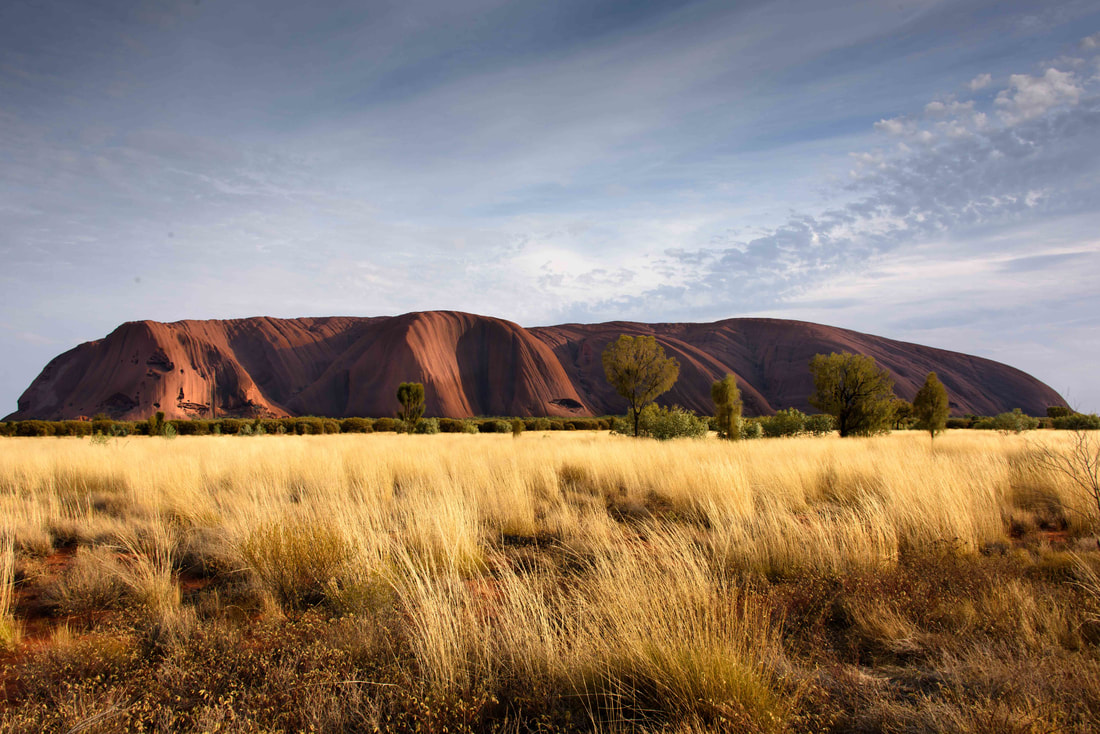
Uluru (a.k.a. Ayers Rock) - a flight, 1600 km of asphalt and a red dirt road through the outback, all for this iconic sight. Thirty-two years ago sister Cheryl and I climbed it, but with over-tourism and a shift towards stronger aboriginal rights for this sacred site, that is now all but illegal. (Uluru, Oct 30)

Ayers Rock & The Olgas - 550 million years ago mountain ranges in eastern central Australia eroded, dumping sand in one pile (Ayers Rock) and rocks in another (Olgas). Over the next 250 million years the piles got higher, ice caps melted leaving behind a sea, the pressure of its weight compressed the material, the sea disappeared, and in the case of The Olgas, rainwater carved out valleys and gorges creating the signature domes. (Uluru)

Fan Palm trees provided some shelter from a light drizzle - apropos for a rainforest. These trees grow 1m every 100 years. As much of the remainder of the country has become more arid, the Daintree Rainforest continues to receive about 80" of rainfall a year. The highest concentration of primitive flowering plants in the world (12 of the 19) survive here.
(Cape Tribulation in Daintree Rainforest, Sept 23)

This facility (part rescue, part endangered species breeding) was called a wildlife immersion habitat - the less aggressive animals roamed about while the humans had to stick to footpaths. After watching the kangaroos lounge around during the heat of the day, they perked up when the temperature dropped and suddenly crowded around niece Allana, Rick & me for some snacking. (Port Douglas, Sept 22)
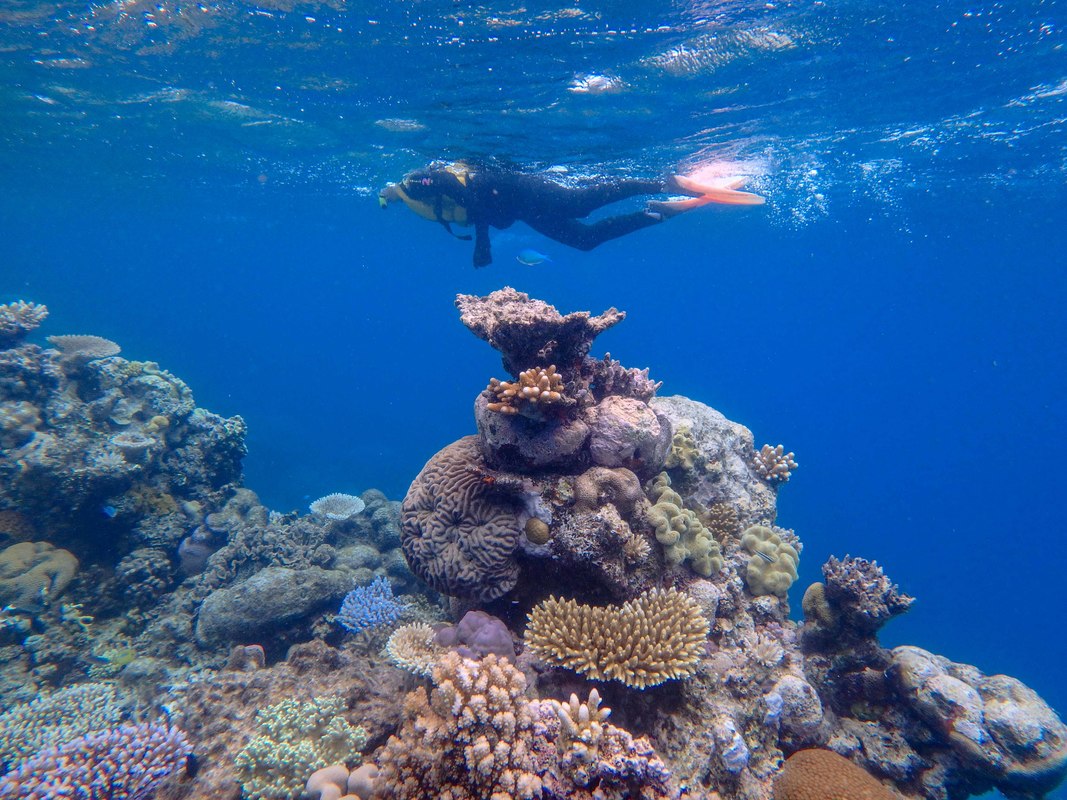
Hearing about rising water temperatures and the subsequent coral bleaching, our snorkeling expectations were low. After two previous years of devastation, this year the water cooled and the reef was regenerating. It turned out to be a spectacular day - full of awe for such beauty.
(Agincourt Reefs {Great Barrier Reef}, Sept 21)
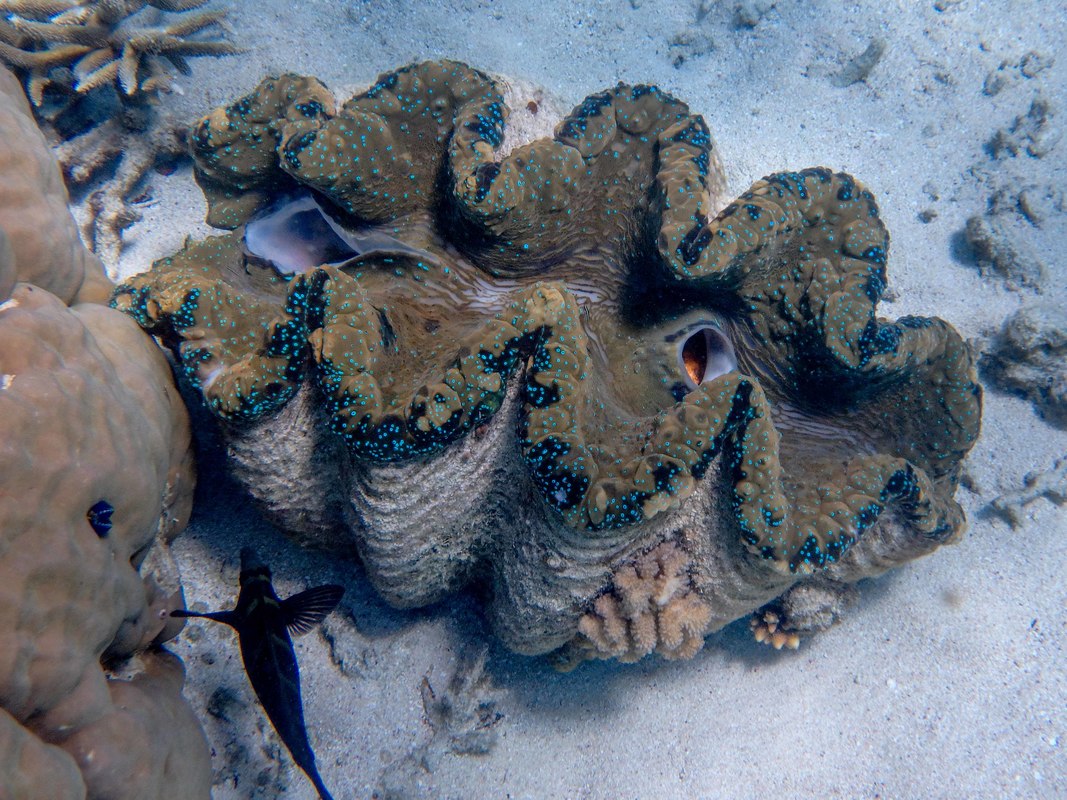
As young children, sister Cheryl and I spent many a weekend swimming in the warm waters surrounding Green Island, oblivious to its special location in the Great Barrier Reef. Long a protected park, thankfully relatively little had changed in 50 years. Giant clams here are the world’s largest bivalve mollusks, often living up to 100 years old. (Green Island, Sept 19)
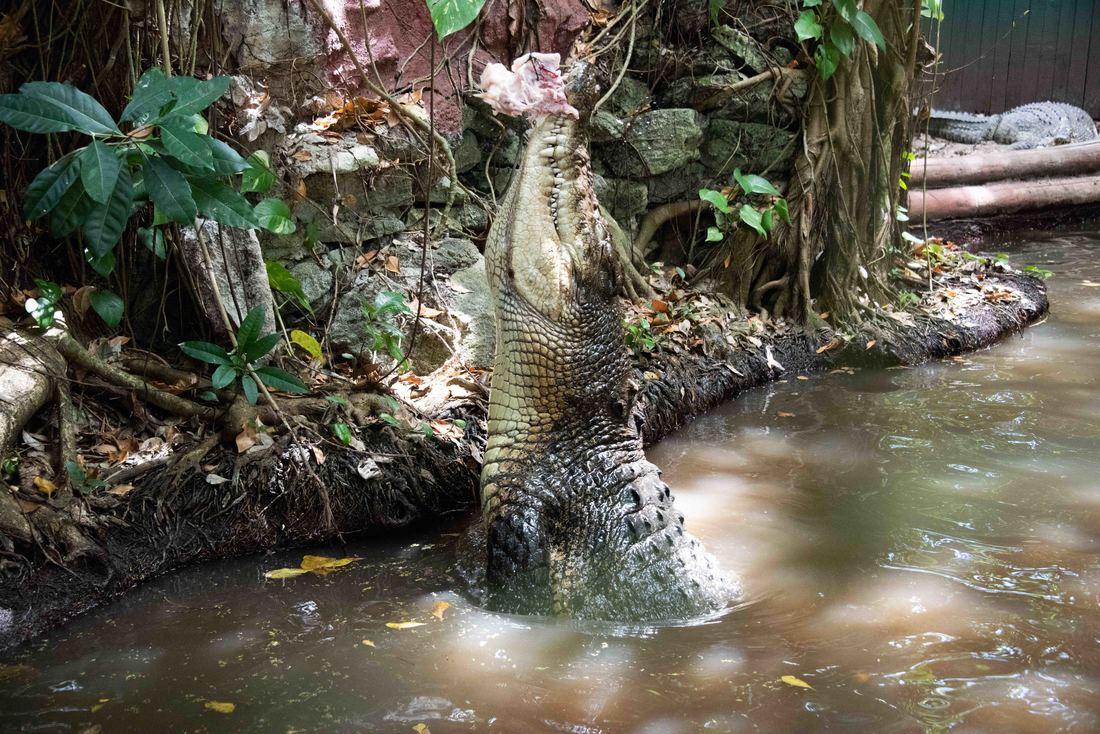
Until recent decades, crocodiles were only heard of in the wilds of sparsely populated northern Australia. Climate change and the reptile’s over-population have changed that. What were once beach lounging havens along Queensland’s coast, now sport signs warning people to stay out of the water and to avoid waterside promenades at night. This nuisance croc, along with others, was shipped to the island to live out the remainder of his life in captivity.

Our eco-cabin abutted the Blue Mountains National Park. A few days each week the guests were authorized to feed a small amount of sunflower seeds to the wild birds. Since we were the only guests, we had them all to ourselves. The crimson rosella parrots were especially bold. (Blackheath, Sept 11-14)

At the end of a hike, loud screeching drew us to a picnic area to find a 100+ sulpher-crested cockatoos. While the majority of these noisy birds ground-fed on insects, others perched in trees watching out for any danger. This behavior has lent the nickname of ‘cocky’ for someone who plays lookout during illegal activities. (Wentworth Falls, Sept 13)



